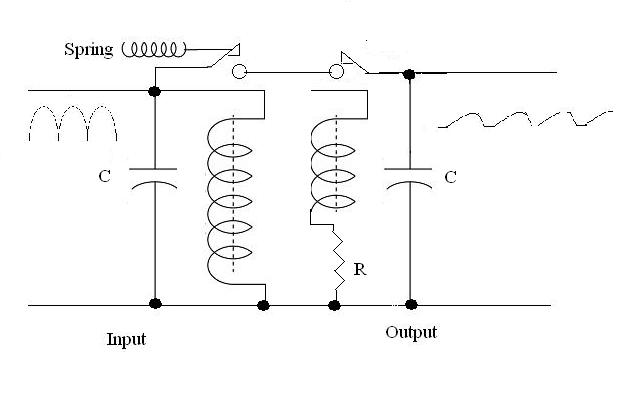This post sponsored by Texas Instruments.
Car enthusiasts appreciate the early innovations that made it possible to manufacture and create automobiles that people could depend upon. Many new (at-that-time) technologies were specifically developed to solve problems that internal combustion engines presented. Brilliant systems like centrifugal timing advance and magneto spark generators bridged the mechanical world to the electrical world, well before solid-state semiconductors were even imagined.
One early innovative technology is evidenced in the mechanical voltage regulator (Figure 1). When there was enough energy from the generator to charge the battery, the first contact would engage. If the voltage was too high as the engine RPM increased, the second contact would remove power from the battery to protect it. Response times could be controlled by varying capacitance, and trigger voltage levels were controlled by the resistance value or coil characteristics.  Figure 1: Mechanical voltage regulators for early automobiles could connect generators to batteries when RPMs were high enough to provide charge. They could also cut off power to the battery and protect it from overvoltage when engine RPM became too high. (Source: Author Contributed Artwork, Jon Gabay 2015)
Figure 1: Mechanical voltage regulators for early automobiles could connect generators to batteries when RPMs were high enough to provide charge. They could also cut off power to the battery and protect it from overvoltage when engine RPM became too high. (Source: Author Contributed Artwork, Jon Gabay 2015)
While mechanical voltage regulators were adequate for many early cars, modern automobiles incorporate much more demanding power requirements, including systems that must remain energized, even when the car is unoccupied and not running. This includes smart systems, such as proximity detectors for lift gate actuation, for example, that turn on every so often, monitor something, log it, and then turn off again.
This scenario brings up a key area of importance: the need to keep strategic systems on while minimizing power draw. Older cars were basically open circuits when the ignition was turned off. Very few systems had access to power, so draw was never really an issue.
The large array of microcontrollers in modern cars need to sleep and wake when needed. They also have the ability to control more intelligent devices and peripherals, including what gets power, and what doesn’t.
Parts such Texas Instruments’ TPS7A1633-Q1, for example, are ideally suited for continuous or sporadic battery-powered applications in which ultra-low quiescent currents are needed to extend battery life. The – 40 to +125 degree C rating is important due to the extremes to which a car can be exposed. But the active quiescent current of 5 uA can be reduced to 1 uA when completely shut down through the use of the micro-controlled CMOS-enable pin. When enabled, the 2 percent accuracy is maintained across the 0 to 100 ma regulated output range. An interesting note is that these fixed-output or adjustable parts accept a 3- to-60 V input allowing them to be used with harvested energy sources as well.
Several modern automotive peripherals can be switched on and off as needed by any task-executive microcontrollers anywhere on the network. For example, the TPIC8101 knock sensor is not needed at all when the engine is not running and can be completely turned off with only 1 uA draw. The PGA450 ultrasonic transducer for range detection can be used to assist or perform parking while the engine is running, or, be used to detect foot movement at the rear to open the trunk hands-free while the engine is off.
Console lighting can benefit as well. Switches no longer switch power directly to a bulb or LED. Instead, switch closure is read by a micro that then commands an output to become active. Even outputs can be multiplexed and share a powered-control bus using parts like the TLC6C598-Q1 medium-voltage low-current shift register LED driver.
In all cases, a supervising micro can put the circuit to sleep when not needed in order to save battery current until a load needs to be activated. No one wants a dead battery when they start their car, especially in extreme conditions. Quality parts that are well-designed and thought-out from the start can extend a battery’s charge and so it’s there when it is needed.
TPIC8101
For more information about this product, click here.
To request a sample, click here.  To buy now at Mouser, click here.
To buy now at Mouser, click here.
PGA450-Q1
For more information about this product, click here.
To request a sample, click here.  To buy now at Mouser, click here.
To buy now at Mouser, click here.
TPS92602-Q1
For more information about this product, click here.
To request a sample, click here.  To buy now at Mouser, click here.
To buy now at Mouser, click here.
TLC6C598-Q1
For more information about this product, click here.
To request a sample, click here.  To buy now at Mouser, click here.
To buy now at Mouser, click here.
TLC6C5912-Q1
For more information about this product, click here.
To request a sample, click here.  To buy now at Mouser, click here.
To buy now at Mouser, click here.
TPS7A1633-Q1
For more information about this product, click here.
To request a sample, click here.  To buy now at Mouser, click here.
To buy now at Mouser, click here.
By: Jon Gabay
Advertisement
Learn more about Texas Instruments





